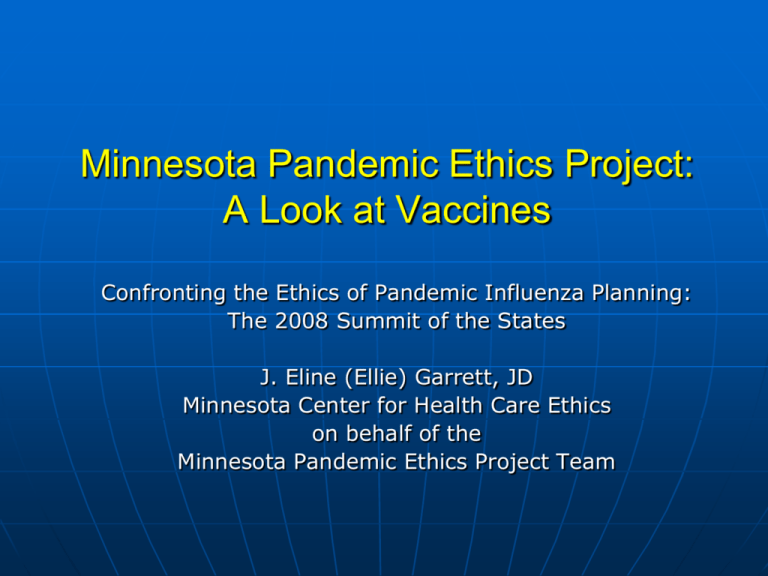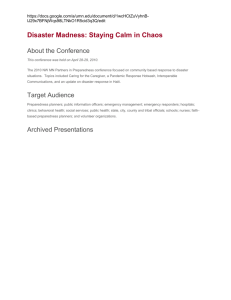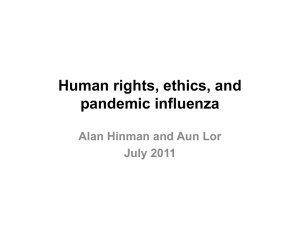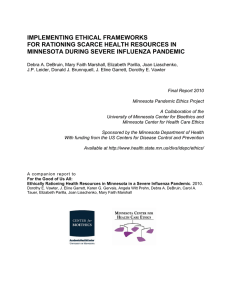Pandemic Ethics Project
advertisement

Minnesota Pandemic Ethics Project: A Look at Vaccines Confronting the Ethics of Pandemic Influenza Planning: The 2008 Summit of the States J. Eline (Ellie) Garrett, JD Minnesota Center for Health Care Ethics on behalf of the Minnesota Pandemic Ethics Project Team Minnesota Center for Health Care Ethics 2006 Pandemic Influenza Ethics Project on Vaccines Vaccine 25 (2007) 6522-6536 2006 Vaccine Project Diverse workgroup, ~35 participants Prioritization based on • Risk of mortality • Vaccine response • Risk of transmission • Key worker role Exposure risk not prioritized MN Pandemic Ethics Project 2007 – present A collaboration between the Minnesota Center for Health Care Ethics and the University of Minnesota Center for Bioethics funded by the Minnesota Department of Health Team Members MN Center for Health Care Ethics • • • • • J. Eline Garrett Karen G. Gervais Ruth Mickelsen Angela Witt Prehn Dorothy E. Vawter U of MN Center for Bioethics • • • • • • • • • Debra A. DeBruin Jeffrey Kahn JP Leider Joan Liaschenko Mary Faith Marshall Steven Miles Elizabeth Parilla Carol Tauer Susan Wolf Scope of Project Ethical frameworks for rationing health-related resources during severe pandemic • Vaccines • N95s • Masks • Antivirals (treatment and prophylaxis) • Ventilators Recommendations, not mandates Pandemic: Assumptions for Severe Pandemic Groups at risk • • • • 2 sources of mortality • • Very young Very old Co-morbidities Healthy 15-40 yr olds Flu Disrupted critical infrastructures Guidance is context-specific Process Comprehensive review of plans and literature • AW Prehn, DE Vawter. Ethical Guidance for Rationing Scarce Health-Related Resources in a Severe Influenza Pandemic: Literature and Plan Review (2008) Convened 100+ Minnesotans to develop preliminary guidance • Diverse – expert and “lay” Community engagement (in process) • Web-based public comment • Small groups – metro and rural Ethical Guidance for Rationing in Severe Pandemic State Florida General Antivirals PPE Vaccines Ventilators + + New York Tennessee + Utah + Wisconsin + + + + + As of March 2008 MN Ethical Frameworks: Overview Statewide, public-private perspective Guidance for decision-making • Commitments • Principles • Goals • Strategies Ethical Commitments Pursue common good • Be accountable, transparent, trustworthy • Promote solidarity, mutual responsibility • Respond fairly, effectively, efficiently Principles and Goals Protect the population’s health • Reduce mortality and serious morbidity Protect public safety and civil order • Reduce disruption to critical infrastructures • Promote public understanding and confidence Principles and Goals (cont.) Treat people fairly, recognizing moral equality of all • Reduce significant differences in mortality/morbidity • Remove barriers to fair access • Honor reciprocity obligations to workers • Reduce significant differences in opportunities for normal lifespan • Use fair process Principles (not goals)are co-equal; must be balanced Strategies: General Do not ration based on: • Social value (gender, socio-economic class, race, citizenship, etc.) • Quality of life • Duration of extended life • First-come, first-served Ration based on combinations of clinical and non-clinical considerations Key Worker Status To reduce mortality and disruption of infrastructures Highest priority goes to workers with additional characteristics, e.g., high exposure, risk of mortality Usually prioritized simultaneously with groups in general population, based on different considerations Age-based Rationing? An alternative to random processes Depends on broad public agreement • Children before adults? • Younger adults before older? • Elders before others? MN not alone in considering age • WHO • US Interagency Working Group • Indiana 2006 recommendations A Look at One Framework: Vaccines De-Prioritized or Excluded Natural immunity Medical contraindications Unacceptable vaccine response Imminently and irreversibly dying Satisfactory alternative protections Strategies: 2 Parallel Tracks with 6 Tiers Track B: General Public Tier 1 Track A: Key Workers + Tier 2 + + Tier 3 + + Tier 4 + Tier 5 + Tier 6 + Track A – Key Workers Tiers based on combinations of: • Risk of occupational exposure • Risk of morbidity/mortality • “Irreplaceability” • Vaccine response Track B – General Population Tiers based on combinations of • Risk of morbidity/mortality • Vaccine response • Possibly age (children at moderate risk prioritized over adults at moderate risk) Moving from 2006 to Current Project Adjust resource-specific frameworks to work as a package (and to coordinate with comprehensive plan) • Don’t systematically disadvantage (or advantage) any group More attention to occupational exposure risk Possibility of age-based rationing (esp. prioritizing kids) Fit with Feds? 2005 HHS guidance for moderate pandemic Proposed federal guidance for severe pandemic: • Multiple goals, tracks and tiers • Protects infrastructures • Prioritizes children before adults in some circumstances • Attends less to differences in response and availability of alternative protections • Attends to homeland security and national defense goals Draft Reports DE Vawter, JE Garrett, AW Prehn, et al. For the Good of Us All: Ethically Rationing Health Resources in Minnesota in a Severe Influenza Pandemic: Preliminary Report (2008) DA DeBruin, E Parilla, J Liaschenko, et al. Implementing Ethical Frameworks for Rationing Scarce Health Resources in Minnesota During Severe Influenza Pandemic (2008) Available (soon) at www.stolaf.edu/mnethx and www.bioethics.umn.edu Next Steps Public comment (web-based) • Watch www.stolaf.edu/mnethx or www.bioethics.umn.edu Public engagement pilot • Small groups • Metro, rural For more information Ellie Garrett MN Center for Health Care Ethics garrette@stolaf.edu (612) 964-9425 Contact info for other team members: www.stolaf.edu/mnethx or www.bioethics.umn.edu




